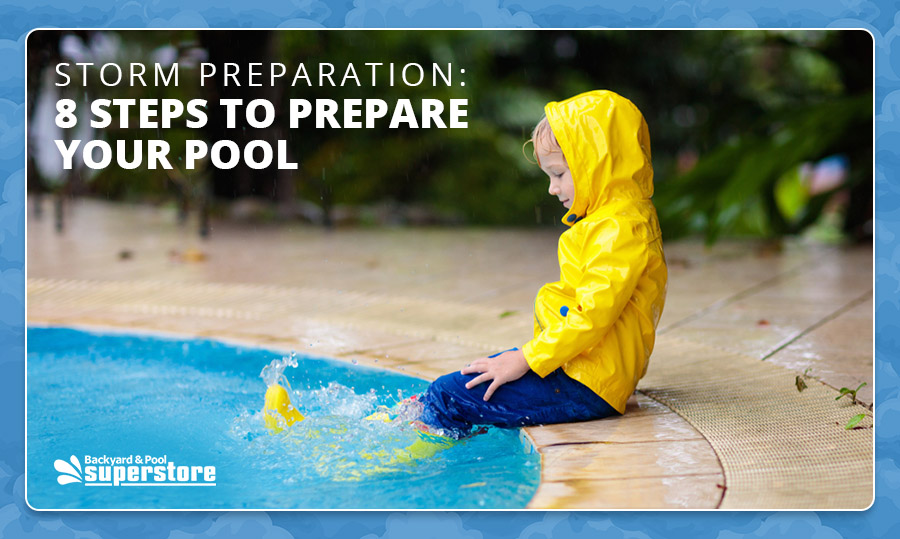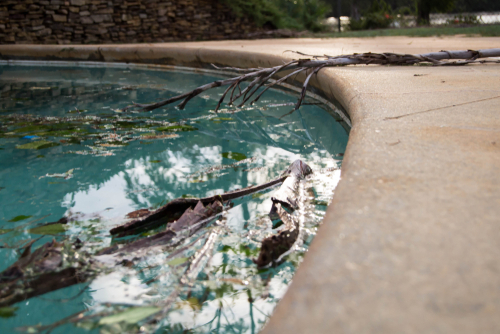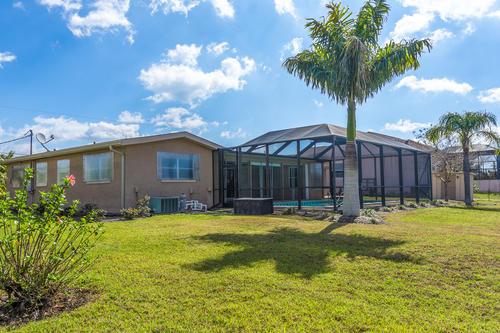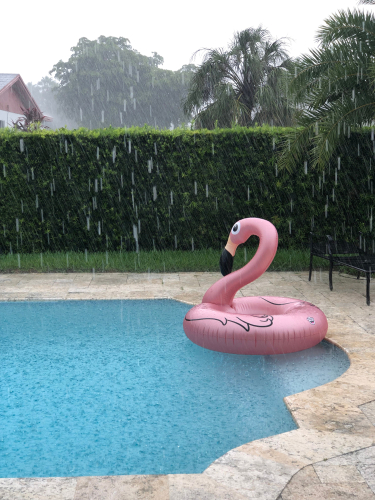
With hurricane season upon us, it’s wise to have a hurricane preparation plan for all aspects of your home. When it comes to pools, many people are unsure of what to do to protect it before a storm hits. Taking precautions to have a pool safety cover or not drain your pool before you evacuate can save your pool from the damaging effects of hurricane winds and rain.
If you are concerned about things such as patio furniture, what to do with swimming pool floats and where to store your pool equipment, you are not alone. In fact, Broward County in Florida has a step-by-step guide for residents who often have to evacuate quickly–and many have pools. Luckily, with a proper plan in place, you can take steps to make sure that your pool survives the storm.
Hurricane and Storm Evacuations
Evacuating during a hurricane or tornado can be especially frightening. For areas that experience these kinds of storms frequently, people have plans in place to ensure that their homes and yards are prepared to weather the storm in their absence.
If you don’t have a storm plan in place, it’s wise to visit your local government’s website for instructions and suggestions. You can download examples of plans and checklists to help you keep everything on track in the event of an evacuation. You’ll also get maps of evacuation routes to follow and lists of mandatory evacuation zones so you will know when you must leave.

If you live in an area prone to natural weather disasters such as hurricanes, you should have an evacuation and storm preparedness plan for your:
Family
Pets
Home
Pool and yard
Reunification of family/pets in case of separation
Keep important documents with you as you evacuate. They will come in handy if you cannot get back to your home, or if your home is destroyed. These include:
Birth certificates, visas, passports and other identification papers
Medical records for both human and four-legged family members
Up-to-date medical information may be required for pets to be allowed into a shelter or hotel
Shelters and hotels may also require current licensing information
Home and auto insurance papers
Make sure your pool is covered under your insurance. If it is damaged or destroyed, you can use your insurance to cover most of the repairs.
Mortgage or lease documents
Vehicle ownership or lease documents
Bank documents
Pay stubs and tax documents
Medication lists and applicable prescriptions
Important photographs and keepsakes
Jewelry and family heirlooms
While your home and pool are important parts of your life, they can be replaced. Do what you can to plan and protect them, but ultimately your life and your family’s lives are more important. Listen to your local authorities and evacuate in the event of a natural disaster.
If you have time, use the following eight steps for storm preparation for your pool.

1.) Turn off power to all of your pool equipment
Your mechanical filters and pumps carry a lot of power. If they all come back online when the power is restored, they could potentially short out your electrical system. Additionally, if there is any lightning or flooding, that could pose a risk to equipment that is plugged in and still receiving electricity.
Turn off the circuit breaker for the pool equipment and unplug it. This will keep any power surges from damaging your mechanical filters and pumps and will protect your electrical system once the power is restored to your area.
2.) Move your mechanical pool equipment to higher ground
To keep your mechanical pool equipment dry and prevent the motors from becoming waterlogged in the event of flooding, move motorized equipment to higher, drier ground if possible. If you have a second floor in your house or shed, this will help protect the motorized equipment and reduce the likelihood of costly replacements later on.
If you do not have higher ground available, wrap your equipment in waterproofing or put sandbags around them to help stem the height of incoming water.
3.) Do not drain your pool
Contrary to popular belief, you should not drain your pool before you evacuate for a storm. Not only will it be easier to clean up a full pool, but the water adds weight to the pool. Pools without water may pop or lift from their foundation. If you have an above-ground pool, the sides may collapse and become irreparable.

Additionally, lots of rain can raise the water table below the pool. Without the weight of the water to keep the pool in place, the pool may shift and crack due to subsidence from the ground underneath. Your pool has been designed to drain properly in the case of rising water levels. Ensure all drainage areas are free of debris or protected so they will function properly.
If you’re unsure if your pool deck drains properly, use a garden hose to test the area and ensure that the water drains quickly and freely away from the pool. If your pool is in an area close to other structures thatmay be damaged by quickly overflowing water, lower the water only by one to two feet.
4.) Shock the pool
If you do not have a pool safety cover, your pool could become filled with debris, which can contaminate the water of your swimming pool. Add extra chlorine for granular debris, and algaecide for contaminating organisms that may make their way into the pool water. This will make for an easier clean-up and reestablishment of your proper water chemistry once you’re ready to re-open your pool.
5.) Remove or protect your pool screens and fences
Many people have protective pool screens, sometimes called a lanai, and these can become damaged in strong storm winds. Some people have pool safety fences to prevent children and animals from entering the pool area. If you have a lanai, you should remove two screens above the chest or waist bar–one at each end of the lanai. This will allow for wind to pass through without creating pressure that can potentially lift and toss the lanai. Additionally, you should remove any doors and store them in a safe location.

If very high winds are expected and you are anticipating significant structural damage to your lanai, you can cut Xs in the other screens. Do not remove all of the screens as this will weaken the overall structural integrity of the lanai. The X marks will allow more airflow and hopefully prevent further damage to the lanai. If you need to re-screen your lanai, you’ll find it cheaper than having to replace the entire cage.
If you remove a safety fence, keep an eye on your pool so that no children or animals inadvertently enter until you can reinstall it. Store your fencing in a safe place.
6.) Store the things that can fly
Patio and swimming pool furniture, pool accessories, in water pool furniture and umbrellas can quickly become dangerous and damaging projectiles in high winds. All furniture, accessories and floats need to be secured for the safety of your home and your neighbors’ homes. If you’re not sure what to do with swimming pool floats, they should be deflated and stored in a safe area.

While you may have heard to throw your patio furniture into the pool, there are a few reasons to stop and reconsider this step. If your patio furniture will be damaged by the water or chemicals in the pool, put them in a protected shed or area of your home instead. If you have an above-ground pool, furniture can damage the liner and walls, potentially puncturing the pool and causing more damage than anticipated.
If you do choose to put your patio furniture into the pool, do so carefully. You don’t want to scrape or damage the liner by throwing heavy objects into the pool, nor do you want to break the furniture. Walk them in and set them carefully on the floor of the pool. When removing them after the storm, do so carefully and slowly.
If you have a charcoal or gas grill, bring it inside–but never use it once it’s indoors. If you have a propane tank, secure it away from the house outside with a chain so it won’t be blown around by the wind. If you don’t have room for larger pool accessories in your home, secure them with heavy-duty ropes and chains outside to keep them in place.
7.) Landscape
While this task should be performed at the start of your pool season, take a look around your yard and perform some preemptive landscaping tasks. If you see low-hanging or loose branches, cut them down. Remove any sticks and shrubs that are potential problems for your pool and yard during high winds.

You should have an experienced professional assess the health of nearby trees every two years to make sure that dead or sick trees are removed. If you have high trees surrounding your lanai or pool deck, it might be wise to have them removed and replaced with shorter trees that will do less damage if knocked over.
8.) Cover your pool with a hurricane cover
If your pool is in an area safe from debris, many people choose to cover their pools with a hurricane pool safety cover. If you have a hurricane pool cover, make sure it is secured properly and can withstand the predicted force of winds. In some cases, it may be wise to leave your pool uncovered if your pool cover is not strong enough and may become damaged. Flimsy pool covers can also become flying objects in high winds, so consider purchasing a strong pool cover made of high-grade, tough materials that will stand up to hurricane-force winds.
When you get home
When you return to your home, it’s essential to first survey your pool for structural or mechanical damage. If you’re unsure, don’t use the pool yet. Call a pool repair company to check out your pool and equipment.
 If your filters and pumps have been in water, don’t plug them in or turn them on yet. Let them air dry for at least 24 hours before attempting to use them. Assess your circuit breaker box to make sure water hasn’t gotten into it. If you’re unsure, contact an electrician to inspect your electrical system before turning it on. You could potentially short out the entire system, start a fire or be seriously injured or even killed.
If your filters and pumps have been in water, don’t plug them in or turn them on yet. Let them air dry for at least 24 hours before attempting to use them. Assess your circuit breaker box to make sure water hasn’t gotten into it. If you’re unsure, contact an electrician to inspect your electrical system before turning it on. You could potentially short out the entire system, start a fire or be seriously injured or even killed.
Carefully begin removing any furniture and debris from the pool. Use a pool skimmer to remove small and floating items. Check the chemistry levels of the pool, including the pH levels, chlorine, cyanuric acid, calcium levels and alkalinity totals of the water. Adjust accordingly to bring the water back to safe swimming levels. You may need to wait a day or two before it’s ready to use again. Turn on the filters after chlorinating and cleaning the pool to allow the pool to readjust to safe water levels.
If your lanai was damaged in the storm, have the structural integrity assessed before entering the pool area. You don’t want the roof of your lanai to collapse while you are standing under it. Once it is deemed safe, you can begin clean-up of your pool area.
Finally, it might seem easier to drain the pool before cleaning it, but this can put the structural integrity of the pool at risk, especially for inground pools in areas where the water table will remain high for some time after a large storm. Only drain the pool as a last resort.
Final Thoughts
If you have a pool and you live in an area prone to large storms, it’s wise to ensure that you have a plan to protect your pool and pool area. Just a few extra steps of preparation can help save time during clean-up and can keep your pool from being destroyed or seriously damaged. If you’re worried about flood damage, consider getting flood insurance to protect your home and pool from the consequences of rising waters.
 Hello Guest,
Hello Guest,  0 item(s)
0 item(s)
